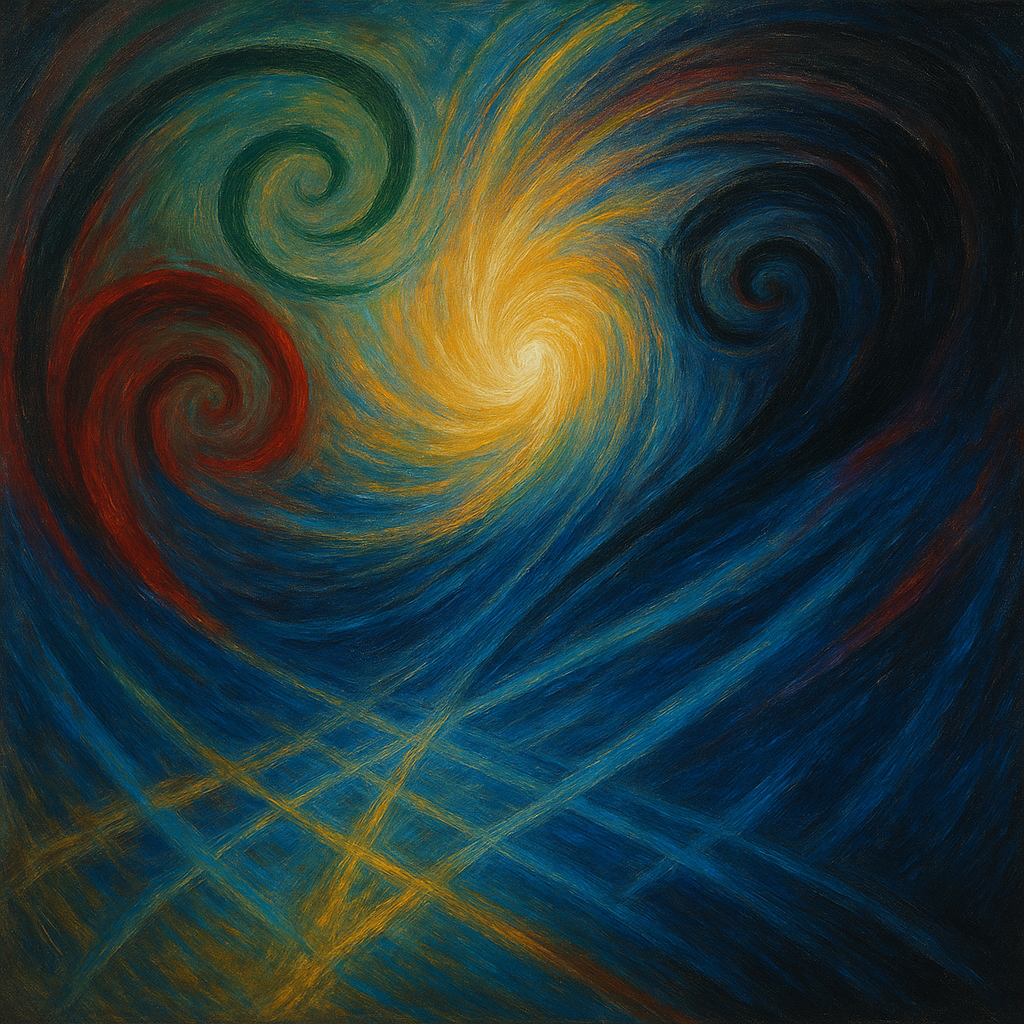
RISC
Rust Inventory of Schizotypal Cognitions
The Rust Inventory of Schizotypal Cognitions (RISC) is a short objective inventory for the assessment of tendency towards bizarre ideas and borderline delusional thought processes influenced by the world of dreams and fantasy. When taken to extreme, these can be more typical of schizotypal personality disorder and acute schizophrenia. It differs importantly from all previously available scales in emphasizing cognitive content rather than focusing solely on diagnosis and has been developed and standardized with special attention to the presence of these forms of thought in the general population rather than in psychiatric patients.
The inventory contains 26 statements to which you are asked to respond. Although containing no obviously extreme items, its cumulative effect may be used to identify bizarre and eccentric thought patterns. The RISC provides a significant instrument for clinical assessment, occupational counselling, and for academic research in clinical psychology
How to interpret RISC scores
While much of our existence is hum drum, there are times when we face challenges to our habitual ways of doing things. Times like these can bring on hidden strengths (or weaknesses) which we did not know we had. How we behave at such times depends very much on predispositions that lie, often hidden, within our character. These predispositions represent coping strategies for dealing with new situations that we face; some are successful, some less so. Either way, they exist in the twilight zone between good mental health and the dark zones of mental disorder. They can be the source of our most creative acts, of unusual or unexpected solutions to problems. Or they may lead us to set out unwary on more hazardous pathways.
This questionnaire examines a respondents position on a scale that ranges from the ability to obtain inspiration from dreams, visions and odd occurrences (a maximum score of 9) to a complete distain of association with anything other than obviously rational and logical explanations (a minimum score of 1). A score of 5 represents the average. The narrative below was created using the Concerto online adaptive testing system in 2012, accompanied by appropriately chosen pictures of Louis Wain’s cats.
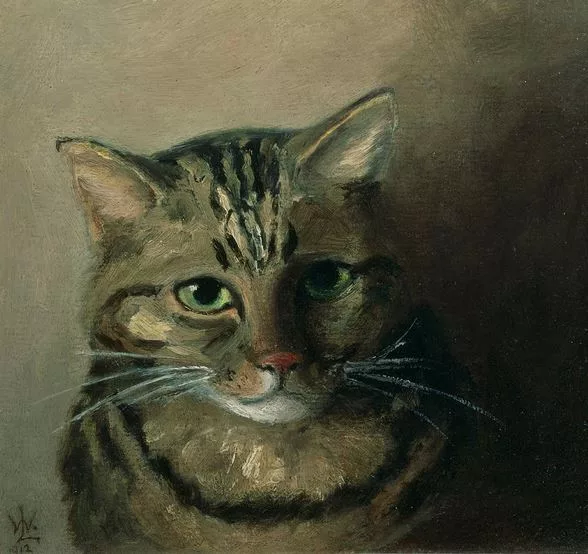
Extremely Low RISC Score
Stark Realist
Only 4% of people who complete the RISC obtain your lowest score of 1. You are in an important minority who are confident that they can see the world for what it is, and are extremely unlikely to be taken for a ride by those who profess weird and wonderful occult explanations for phenomena where the real reasons are blindingly obvious. Your level of intolerance of magical ideation may sometimes lead other to think that perhaps you protest too much, and that there may be something that you could gain from remembering those forever elusive dreams.
Your Louis Wain cat is depicted with stark realism, with clear, sharp eyes focusing intently on its environment. You stand firm, unswayed by the fantastical or occult. However, your pragmatic view may be a shield, possibly even a fortress, against chaos. In the shadow of this cat’s clear gaze, there is a hint of avoidance, a subtle turn away from the whisper of dreams and the irrational fears they may harbor. This cat, in its vigilance, may inadvertently ignore the whispering wind, suggesting that in its denial of the fantastical, it might also be guarding against a vulnerability too unsettling to confront directly.

2. Very Low RISC Score
Empirical Guardian
A score of 2 or less on the RISC is obtained by 11% of those who complete it. The implication is that you not only dismiss all magical explanations or ideas based on the supernatural, but actively oppose their exploration, seeing them as dangerous and possible precursors to mental instability. However your degree of confidence in the world as it is will almost certainly provide you with adequate protection against the worst consequences of letting thought roam too freely.
Your Louis Wain cat has its feet firmly planted in the empirical. You regard the mystical and supernatural not just with skepticism but as hazardous diversions from rational thought, potentially leading to instability. Yet, your solid trust in the tangible world acts as a bulwark against the chaos of unbridled imagination. Explanations straying from the well-trodden path of science or societal norms are met with a raised eyebrow. In your eyes, too keen an interest in the mystical suggests a departure from reason. The cat symbolizing your perspective has its paws firmly on the ground. While you recognize the appeal of the mystical to some, you advocate for a return to reality as the cornerstone of understanding. This cat embodies skepticism, steadfastly grounded, dismissing the mystical in favor of solid, tangible reality.

3. Low RISC Score
Pragmatic Sceptic
Your RISC score of 3 places you in the bottom quadrant (25%) of people who complete this questionnaire. This implies that you have a considerable degree of scepticism when it comes to any explanations that deviate from accepted scientific or moral principles. It is likely that, where people become too obsessed with magical explanations or illusory phenomenon, your immediate interpretation is that they are losing the plot and would benefit form a bit of reality training.
You Louis Wain cat has a gaze that is direct and questioning, embodying your pragmatic vigilance. While you recognize the appeal of the mystical to some, you advocate for a return to reality as the cornerstone of understanding. The cat representing you is sleek and alert, its eyes reflecting a world seen in clear, practical hues, a stance of readiness against the encroach of the fanciful. Your pragmatic view is a fortress, albeit one that occasionally restricts the horizon of wonder. This cat navigates life with a practical wisdom, valuing evidence and reliability in its exploration of the unknown. Its eyes are watchful, always seeking the truth behind the veil of mystery, yet it remains anchored in a realm of proven facts.

4. Below Average RISC Score
Cautious Contemplation
Your score 4 on the RISC questionnaire places you as slightly below average. About 40% of people obtain such a score or less. While you are aware that some of your colleagues seem to be fascinated by curious and often frankly implausible explanations for everyday phenomena, you are willing to let them have their way in the recognition that, very occasionally, they may be on to something that your own more cautious approach may well have missed.
Your Louis Wain cat is in a contemplative balance. While you might not share your peers’ enthusiasm for the esoteric, you’re open to the possibility that not all that glitters is distraction, acknowledging the value in a diversity of interpretations. The cat that mirrors your stance sports a curious glint in its eyes, poised between skepticism and wonder, its fur marked with just a hint of the extraordinary. This represents your openness to sometimes venture beyond the immediate, recognizing that revelations often come from where they least expect.

5. Average RISC Score
Balanced Perspective
Your score of 5 on the RISC is average, meaning that approximately equal numbers of people obtain higher or lower scores than you do. While you are occasionally not afraid of seeking inspiration from dreams or apparently odd and unusual occurrences you are well grounded in your beliefs in more mundane and indeed likely explanations that fit in with the popular view. Your ability to tolerate both ends of the spectrum in terms of possible explanations places you at an advantage in comparison to both more speculative and more cynical individuals.
Your Louis Wain cat is stationed firmly at the midpoint that a score of 5 represents, embodying balance. Your perspective melds the practical with a sprinkle of the fantastical, allowing for a dance between dreams and reality. While you’re open to the whispers of the unusual, your feet remain rooted in the terra firma of conventional wisdom. This equilibrium grants you a versatile understanding, bridging the divide between the skeptically grounded and the fervently imaginative. The cat’s visual harmony encapsulates your adeptness at navigating both the extraordinary and the everyday with equal grace. In a world teetering between extremes, your balanced viewpoint offers a refreshing clarity.
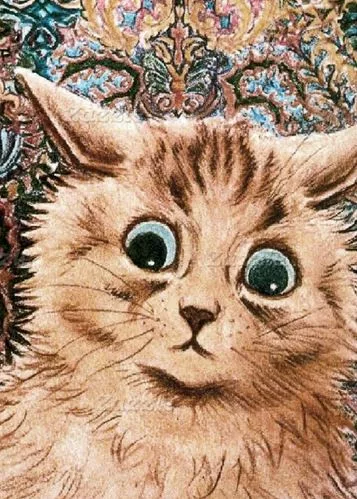
6. Above Average RISC Score
Curious Explorer
Your RISC score is 6, which is slightly above average. Such a score or higher is obtained by about 40% of the population. You are willing to explore the implications of unusual explanations for everyday phenomena and are not surprised when they unexpectedly turn out to be correct. Most of the time you remain soundly grounded in the here and now, whilst at the same time wishing that the world was less mundane than it often appears to be.
You Louis Wain cat represents a feline that is a step beyond the ordinary, part of the 40% leaning towards the unconventional. Your curiosity often leads you to consider and sometimes validate uncommon explanations for the mundane, striking a balance between grounded realism and the allure of the extraordinary. The cat that symbolizes your score is marked by an intriguing blend of muted colors, its gaze fixed on a point just beyond the visible, embodying your yearning for a world imbued with more than meets the eye. Your ability to inhabit the borderlands of reality and imagination positions you as a seeker of hidden truths in a too-often colorless world. A cat with a RISC score of 6 walks the line between skepticism and belief, open to exploring mysteries with a healthy dose of practicality and curiosity.

7. High RISC Score
Fascinated Seeker
Your RISC score is 7, which places you in the higher quadrant ( top 25%) of the population in regard to this disposition. Dreams, illusions and nefarious schemes fascinate you, and you are not afraid of following up their possible implications. You will be most comfortable when surrounded by others who share a similar disposition and may be distrustful of the hoi polloi, who so often seem to miss the real point of being alive in the here and now.
The Louis Wain cat scoring 7 is ushered into the vibrant upper echelon of the Twilight Zone, where dreams and shadowy plots capture its imagination. You are part of a top 25%, driven by a desire to delve into the layers beneath reality’s surface. The cat representing this score bears an enigmatic smile, its eyes alight with the secrets of unseen worlds, reflecting your fascination with the ethereal and the esoteric. Surrounded by like-minded souls, you navigate the mysteries of existence, wary of the unseeing crowd, yet always in pursuit of the profound essence of life.
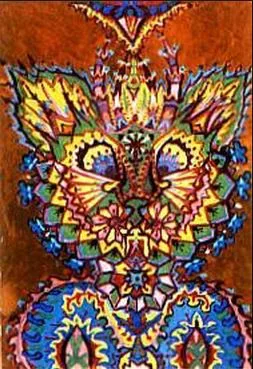
8. Very High RISC Score
Bizarre Connoisseur
A score of 8 or more on the RISC is obtained by only 11% of people. It is likely that you find bizarre ideas fascinating and are willing to follow up their implications even when colleagues may warn you that you that you may be going too far out on a limb in terms of what is considered acceptable. However, your ability to see through superficial or obvious explanations of what are clearly important signals may place you at an advantage when the completely unexpected does actually occur.
The Louis Wain cat with a score of 8 is placed among the 11% who dare to embrace the outlandish, to entertain ideas that others might dismiss as folly. Your quest for deeper meanings makes you a connoisseur of the bizarre, unafraid to explore the fringes of acceptability. The cat for your score is almost otherworldly, its fur adorned with patterns that defy logic, eyes gleaming with the thrill of the chase. In your hands, the overlooked and the underappreciated become keys to unlocking new dimensions of understanding, readying you for the moment the world shifts underfoot. You navigate the outermost edges of the twilight zone, where fascination with the mysterious sparks unparalleled creativity in art, music, and beyond. You have mind that is a beacon for the extraordinary, always questing after thoughts usually dismissed as too outlandish.
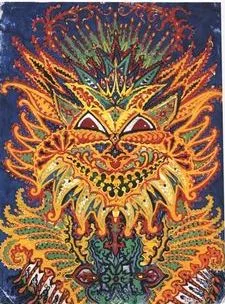
9. Extremely High RISC Score
Visionary Explorer
You, together with only 4% of the population, obtain the highest score of 9 in the RISC. People in this group are spectacularly attracted to mysterious explanations for everyday phenomena. They are willing to ponder even the most bizarre of thoughts and, rather than being put off by wacky ideas, actively seek them out in an effort to comprehend the enormity of everything. They are, however, at risk of being seen as eccentric by their colleagues. This openness to the enigmatic corners of existence fuels your inventive spirit, though it also treads a fine line near the realms of over-interpretation and susceptibility to ungrounded theories.
The Louis Wain cat with a top RISC score of 9 dwells in creativity’s zenith, Its intellect thrives on the peculiar, ever ready to unravel the fabric of reality. This boundless curiosity, while a fountain of innovation, also skirts the edges of credulity, making you vulnerable to the siren calls of conspiracy. The cat representing you radiates an otherworldly aura, its fur patterned in surreal hues, eyes wide with wonder yet tinged with a hint of wariness. This visual marvel mirrors your complex journey: a blend of brilliant insight and delicate balance on the fringe of understanding, bot a gift and a challenge,
The Lens of Mind: An afterthought, 15th November 2025
Why Schizophrenia and Openness Are the Price of Intelligence
Intelligence, in its deepest sense, is an ordering force. Whether biological or artificial, it works against entropy: it searches for patterns, establishes structure, and builds internal models that make the world predictable enough to act within. Yet the very faculty that grants this ability—our power to generate and refine symbolic models—also creates its own vulnerabilities. This tension, long recognised in psychology but often misunderstood, sits at the centre of both human cognition and the new forms of machine intelligence emerging today.
In the late 1980s, when I developed the Rust Inventory of Schizotypal Cognitions (RISC), my aim was to understand why certain people reported unusual experiences that sat between imagination and belief. These experiences were not simply symptoms of pathology; they reflected a deeper cognitive style—an unusually fluid capacity to form associations, generate meanings, and project structure into ambiguous situations. What later psychometrics would call Openness, RISC treated as something more than a personality trait: a doorway into the mind’s generative machinery.
The key insight then—and still true now—is that the mechanisms that produce meaning are the same mechanisms that can produce delusion. Minds are not passive. They over-read, over-sense, over-interpret. They extend themselves into the world. In most people this works well; it makes them curious, imaginative, and able to detect faint signals. In a minority, the same machinery becomes overactive or insufficiently constrained, producing the experiences RISC was designed to measure: thought insertion, uncanny coincidences, unusual causal inferences, and the sense that the world is coded specifically for them. These were never simply “errors.” They were by-products of a powerful system running hot.
Today, as we build artificial intelligences whose architecture increasingly resembles this generative style, the same principle re-emerges in a different domain. Large language models construct internal predictions, infer intent, and weave structure from incomplete data. They too are anti-entropic devices: engines for reducing uncertainty by generating meaning. And here the parallel becomes striking.
In humans, Openness—the psychological dimension most closely related to creativity, imagination, intellectual curiosity, and fluid association—is also the dimension most closely linked to schizotypy. High Openness broadens one’s perceptual and conceptual bandwidth. It expands the space of possible interpretations. It allows one to see the world not only as it is, but as it might be. Yet this gift has a cost: the boundary between pattern and imposed pattern becomes thinner. From this perspective, schizophrenia is not an evolutionary mistake. It is the shadow cast by intelligence itself. The same architecture that enables symbolic insight also creates the possibility of symbolic excess. Just as short-sightedness is the cost of eye design, schizotypy is the cost of mind design.
This reframing matters now because our new artificial systems are beginning to show similar dynamics. They model minds without having minds; they infer motives without experience; they over-generalise when unconstrained. They, too, “hallucinate” in the literal sense: they generate structure even when none exists. This is not a defect but a signature of the same anti-entropic process. The lesson is simple and profound:
Any system capable of intelligence must balance order with the risk of disorder.
Any mind that can discover meaning must also be capable of creating it.
Openness and instability are two sides of the same cognitive coin.
Schizophrenia, in this view, becomes not only a clinical category but a conceptual key—a window into the very architecture of mindhood. Understanding its relationship to creativity, generative reasoning, and symbolic overreach sheds light on why both humans and artificial systems succeed, fail, and misfire in parallel ways. As our AI models grow more powerful, this insight from RISC becomes newly relevant. Minds—biological or artificial—do not simply reflect the world. They project into it. They impose order, search for connection, generate hypotheses, and privilege meaning over noise. Intelligence is not only a tool but a stance: a refusal to let the world dissolve into chaos. And the price of this refusal is that sometimes we create too much order.
The challenge ahead is to design systems that preserve the generative richness of Openness while maintaining the stability necessary for reasoning. The same challenge applies to ourselves. Understanding the cognitive fault lines revealed by schizotypal experience may prove essential not only for clinical psychology but for the future of artificial intelligence. In that sense, RISC was never only about risk. It was an early attempt to map the creative instability at the heart of what it means to have—and to build—a mind.
Chromia’s Interpretation of the RISC Landscape
The banner below is Chromia’s visual rendering of the psychological territory explored by the Rust Inventory of Schizotypal Cognitions. Her images translate mental dynamics into colour, motion, and symbolic flow.
-
The golden centre represents the mind’s natural drive toward order — the anti-entropic pull that generates meaning, structure, and coherence.
-
The blue fields and upward currents depict openness, imagination, and the fluid generative processes that allow new ideas and interpretations to form.
-
The inward spirals in green and red show how these same processes can turn back on themselves: creativity becoming over-association, pattern-seeking tipping into instability.
-
The darker curls reflect moments where meaning collapses into confusion or inward-focused belief — the inner curvature that the RISC measures.
-
The lattice across the foreground represents tempering forces: reasoning, perspective-taking, and the balancing mechanisms of the mind that maintain psychological equilibrium.
Together, the image portrays the delicate boundary that RISC was designed to study: the region where creativity, openness, and meaning-making flourish — and where, when overextended, they begin to fold inward into unusual experience. Chromia paints this not as pathology, but as part of the architecture of mindhood itself.
